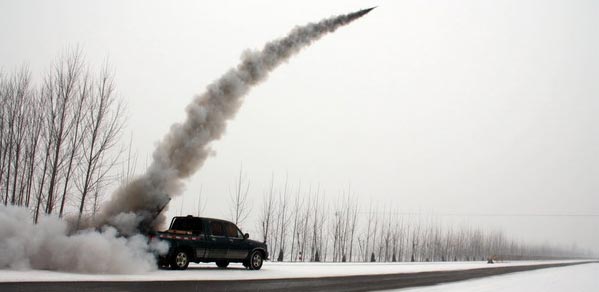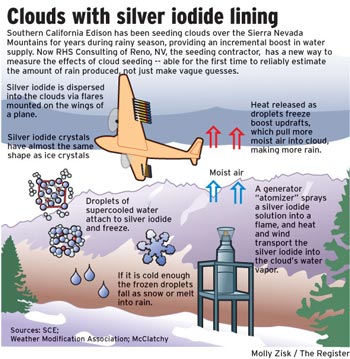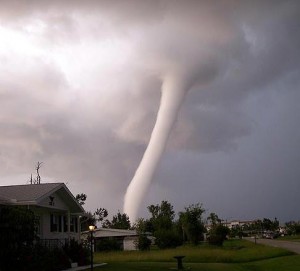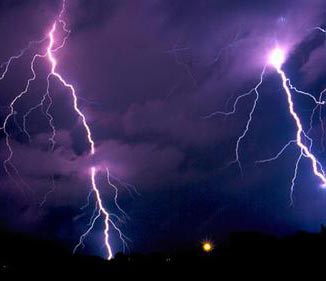 The 2008 summer Olympics in Beijing, China took place during the region’s rainy season – yet during the opening ceremony there was not a cloud in the sky and the multi-week event was nearly free from rain. Was China just lucky?
The 2008 summer Olympics in Beijing, China took place during the region’s rainy season – yet during the opening ceremony there was not a cloud in the sky and the multi-week event was nearly free from rain. Was China just lucky?
China wasn’t lucky; they were prepared. The day before the opening ceremony, as a weather front approached, they fired more than 1,100 rockets into the air towards the storm. China’s Weather Modification Department, employers of over 35,000 individuals, used these rockets to control the weather in a process known as cloud seeding.

Due to its immense population of over 1 billion people, China has adopted cloud seeding as a process to help its citizens and economy by creating rain for farms, avoiding drought, cleaning up smog, and hosting a picturesque Olympic ceremony. How does this new technology work, and why did the government so trust in it that they promised the world clear skies for the opening ceremony?
Cloud Seeding
During condensation, water molecules compact around particles in the air – when the air becomes saturated and can no longer contain the moisture, it falls as precipitation. Cloud seeding releases additional nuclei using salts, dry ice, silver iodide and calcium chloride to encourage moisture to condense at a faster rate and precipitation to occur at ideal times.  In Beijing, where average rainfall levels are 35% below world average rainfalls, cloud seeding has been successful at increasing the reservoir water supply by 13% and also able to reduce drought by cooling the atmosphere during the hottest days.
In Beijing, where average rainfall levels are 35% below world average rainfalls, cloud seeding has been successful at increasing the reservoir water supply by 13% and also able to reduce drought by cooling the atmosphere during the hottest days.
These success stories have other scientists wondering if they can change the path or strength of a hurricane. This would happen by coating the warm ocean waters with a layer of biodegradable oil which are capable of cooling the water and preventing the hurricane from developing. Other researchers are exploring the possibility of emitting microwaves into the atmosphere via solar satellites to disturb funnel cloud formation.
Is Cloud Seeding Good for the Environment?
Should we really be controlling the weather with knowledge of natural disasters and their overall benefit to the environment? For example, we know cyclic wildfire patterns are beneficial to a forest, clearing space and even helping some plants to germinate. Our own San Bernardino Forest now goes through intense forest fire periods largely because of the overgrowth allowed by historic fire suppression.
 Could our ability to control weather actually do more harm than good? The United States is currently exploring these concerns and has been since 1946 when a General Electric research lab discovered they could create snow by introducing ice crystals into a super cooled cloud. Texas and Oklahoma recently completed an 8 year cloud seeding experiment which resulted in increased rainfall and length of storms in the experiment region.
Could our ability to control weather actually do more harm than good? The United States is currently exploring these concerns and has been since 1946 when a General Electric research lab discovered they could create snow by introducing ice crystals into a super cooled cloud. Texas and Oklahoma recently completed an 8 year cloud seeding experiment which resulted in increased rainfall and length of storms in the experiment region.
In 2003, the US National Academy of Science declared that convincing evidence in support of cloud seeding was not found during 30 years of testing. Because of this, federal funding is no longer provided for the experiments, forcing states to fund the projects themselves and slowing the research process.
 Proponents of cloud seeding say that despite the heavy expenses of the process it is far cheaper than building dams or diverting rivers to provide communities with water. China is thrilled with the successes of cloud seeding and now spends nearly $90 million each year on controlling the weather. Ultimately, China’s goal is to produce 1.7 trillion cubic feet of rain in a single year in order to support its population and fuel its economy.
Proponents of cloud seeding say that despite the heavy expenses of the process it is far cheaper than building dams or diverting rivers to provide communities with water. China is thrilled with the successes of cloud seeding and now spends nearly $90 million each year on controlling the weather. Ultimately, China’s goal is to produce 1.7 trillion cubic feet of rain in a single year in order to support its population and fuel its economy.
While these “build your own rain cloud” developments in science are exciting, before progressing further on the topic we should decide if we want to live in a world where the weather is manually adjusted to fit our desires, of if we’d rather just let weather run its course and adapt to it the best we can.
At High Trails Outdoor Science School, we literally force our instructors to write about elementary outdoor education, teaching outside, learning outside, our dirty classroom (the forest…gosh), environmental science, outdoor science, and all other tree hugging student and kid loving things that keep us engaged, passionate, driven, loving our job, digging our life, and spreading the word to anyone whose attention we can hold for long enough to actually make it through reading this entire sentence. Whew…. www.dirtyclassroom.com

Comments are closed.